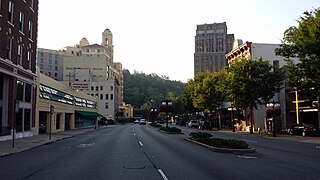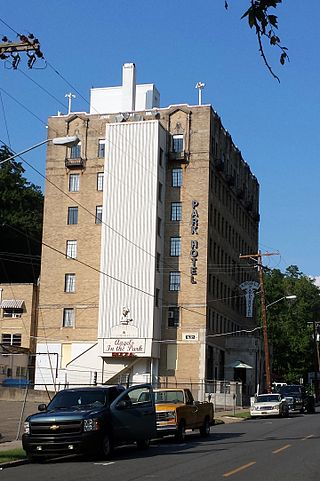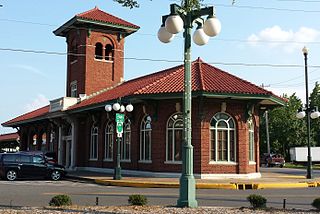
Hot Springs is a resort city in the state of Arkansas and the county seat of Garland County. The city is located in the Ouachita Mountains among the U.S. Interior Highlands, and is set among several natural hot springs for which the city is named. As of the 2020 United States Census, the city had a population of 37,930, making it the eleventh-most populous city in Arkansas.

Hot Springs National Park is a national park of the United States in central Garland County, Arkansas, adjacent to the city of Hot Springs. Hot Springs Reservation was initially created by an act of the United States Congress on April 20, 1832, to be preserved for future recreation. Established before the concept of a national park existed, it was the first time that land had been set aside by the federal government to preserve its use as an area for recreation. The hot spring water has been popularly believed for centuries to possess medicinal properties, and was a subject of legend among several Native American tribes. Following federal protection in 1832, the city developed into a successful spa town.

Lake Hamilton and Lake Catherine are a pair of man-made lakes located in Hot Springs, Arkansas, serving as a tourist attraction for the area. Both lakes were developed by Arkansas Power & Light. The lakes were built as part of Federal Project #271 a hydroelectric development for creating hydroelectric dams.

The Arlington Resort Hotel & Spa is a resort in the Ouachita Mountains of Hot Springs National Park, Arkansas, home of Oaklawn Race Track and the Arkansas Derby. The Arlington's design inspired the Baker Hotel in Mineral Wells, Texas. The hotel is located at the north end of "Bathhouse Row".

Bathhouse Row is a collection of bathhouses, associated buildings, and gardens located at Hot Springs National Park in the city of Hot Springs, Arkansas. The bathhouses were included in 1832 when the Federal Government took over four parcels of land to preserve 47 natural hot springs, their mineral waters which lack the sulphur odor of most hot springs, and their area of origin on the lower slopes of Hot Springs Mountain.

The Stitt House is an Italianate-style house located in Hot Springs, Arkansas. It is listed on the National Register of Historic Places.

George Richard Mann was an American architect, trained at MIT, whose designs included the Arkansas State Capitol. He was the leading architect in Arkansas from 1900 until 1930, and his designs were among the finalists in competitions for the capitols of several other states.

The Central Avenue Historic District is the historic economic center of Hot Springs, Arkansas, United States, located directly across Central Avenue from Bathhouse Row. Built primarily between 1886 and 1930, the hotels, shops, restaurants and offices on Central Avenue have greatly benefited from the city's tourism related to the thermal waters thought to contain healing properties. Built in a variety of architectural styles, the majority of the buildings constituting the district are two- or three-story structures. The district was listed on the National Register of Historic Places in 1985, at which time forty contributing structures were identified; 101 Park Avenue was added in 2007, and a boundary decrease was approved in 2019.

The Park Hotel was a seven-story hotel in downtown Hot Springs, Arkansas near Bathhouse Row within Hot Springs National Park. Built in 1930 by Thompson, Sanders and Ginocchio in the Spanish Revival style, the hotel was added to the National Register of Historic Places in 1982. It closed in 2020.
Mayberry Springs is a historic traveler's accommodation and early resort on United States Route 270 near Crystal Springs, Arkansas. Located roughly midway between Hot Springs and Mount Ida, the main surviving structure is a single-story wood-frame structure with vernacular Greek Revival styling. A shed-roof porch extends across its front, ending in an enclosed room at one end. The building was probably built about 1895, but the site has a documented history as a stagecoach stop and bathhouse at least as far back as 1850. Historic archaeological remains at the site include cabin foundations and multiple wellheads.

The Missouri-Pacific Railroad Depot-Hot Springs is a historic former railroad station at Broadway and Market Street in Hot Springs, Arkansas. It is a single-story masonry structure, roughly V-shaped due to the triangular parcel, with a tile hip roof with broad eaves supported by Italianate wooden brackets. A Tuscan tower rises above the station, and its walls consist of bays of compound round-arch windows. The station was built c. 1917 by the Missouri-Pacific Railroad, and is a major reminder of the importance of the railroad to the growth and success of Hot Springs as a resort community.

The Ouachita Avenue Historic District encompasses a commercial and residential district south of Bathhouse Row in downtown Hot Springs, Arkansas. It includes an area of three square blocks bounded by Ouachita Avenue, Orange and Olive Streets, and Central Avenue. This area was completely devastated by a fire in 1905, and damaged by another in 1913, and it is after these events that its most significant buildings were built. It contains a variety of commercial buildings (mostly on Ouachita Avenue, multiunit and single-family housing, in a dense pedestrian-friendly urban setting.

The Pleasant Street Historic Historic District is a historic district encompassing the historic African-American community area of Hot Springs, Arkansas. It is located just southeast of the city's famous Bathhouse Row area, centered on a four-block stretch of Pleasant Street between Jefferson and Church Streets. The 30-acre (12 ha) district includes 93 buildings, most of them residential. The area was developed between about 1900 and 1950, with most of the development taking place after 1920. Prominent non-residential buildings include the Visitor's Chapel A.M.E. Church at 317 Church Street, and the Woodmen of Union Building, a four-story brick building on the 500 block of Malvern Avenue.

The Woodmen of Union Building is a historic commercial building at 501 Malvern Avenue in Hot Springs, Arkansas. It is a four-story structure, built mainly out of brick and ceramic blocks, although its southeastern section has upper levels with wood framing and finishing. Its main facade has an elaborate projecting entrance portico, with the entrance set in an elliptical-arch opening supported by fluted pilasters. The interior retains significant original features, including a bank vault, marble wainscoting, and a 2,500-seat auditorium. It was built in 1923-24 for the Supreme Lodge of the Woodmen of Union, an African-American social organization, which operated it as a multifunction bathhouse, hotel, hospital, bank, and performance venue. It was purchased in 1950 by the National Baptist Association.

The Hot Springs Federal Courthouse is located at 100 Reserve Street in Hot Springs, Arkansas. It is a three-story building, with a steel frame clad in orange brick, with porcelain panels and aluminum-clad windows. It was designed by the Little Rock firm Wittenberg, Delony & Davidson, and was built in 1959–60 on the site of the Eastman Hotel, once one of the city's largest spa hotels. It is one of the city's best examples of commercial International architecture.

The Hill Wheatley Downtowner Motor Inn is a historic hotel at 135 Central Avenue in Hot Springs, Arkansas, United States. It is a ten-story rectangular structure, finished in glass, brick, and metal, in the Mid-Century Modern style. Its main block is set back from the street, behind a two-story entry retail section. The tower is fronted mainly by balconies with panels of redwood screening to provide visual relief and shade. The hotel was designed in 1965 by Noland Blass Jr. of Erhart, Eichenbaum, Rauch & Blass for Hill Wheatley, one of Hot Springs' major promoters. It is one of the only surviving hotels in the city with its own bathhouse.

The Aristocrat Motor Inn is a historic hotel building at 240 Central Avenue in Hot Springs, Arkansas. It is a large seven-story structure, with a six-story U-shaped tower set on a basically rectangular ground floor. It is finished in glass, brick, and metal, in the Mid-Century Modern style. The tower is organized around a central courtyard, with the interior facades in a sawtooth pattern to maximize light coming into the hotel rooms facing inward. The hotel was built in 1963 by Samuel Kirsch, a local businessman engaged in a variety of pursuits. It was one of the first hotels built along the city's Central Avenue to feature a Modernist exterior. It was operated as a hotel until 1978, and was after converted into low-income housing.
The Dr. Albert H. Tribble House is a historic house at 100 Trivista Right Street in Hot Springs, Arkansas. It is a 3+1⁄2-story brick building, with a gabled roof and Classical Revival styling. Its main facade is symmetrical, with tall ground-floor windows flanking the main entrance, which has an arched transom and sidelight windows. It was built in 1938, and is possibly a design of Hot Springs architect Iven Donald McDaniel. Albert H. Tribble, for whom it was built, was prominent local physician.
Irven D. McDaniel (1894-1960) was an architect based in Arkansas and Tennessee and Irven G. McDaniel was his son and also an architect who practiced in Hot Springs, Arkansas.


















